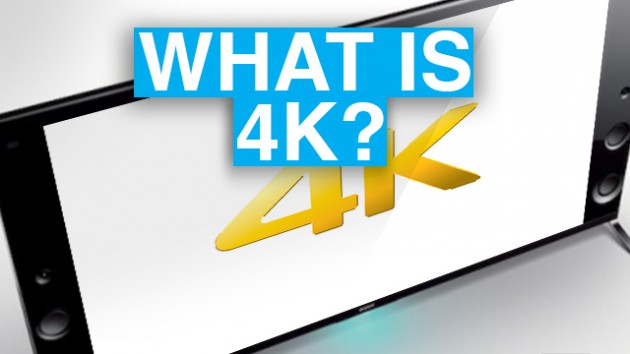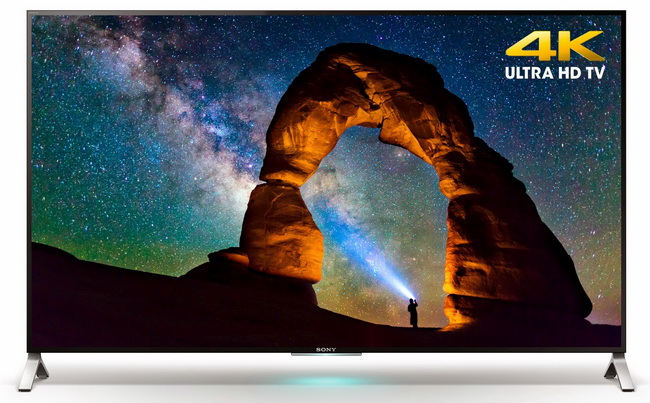Last updated on 2021-03-15, by
Everything you should know about 4K - What is 4K?
4K has been a popular word for a long time, aka UHD, Ultra HD, Ultra-High Def, 4K resolution. It seems to be the main trend of future TV and video enjoyment. However, many people actually have very little acquaintance about what is 4K and the relationships between 4K, 4K display, 4K TV, and 4K video. In this post, we would like to deliver a detailed introduction on these terms and let you know more about 4K.
Part 1: What is 4K?
What is 4K or what is 4K resolution? 4K, also called 4K resolution, refers to a display device or content having horizontal resolution on the order of 4,000 pixels and vertical resolution on the order of 2000 pixels. 4K resolution is 2160 rows and 3840 columns of pixels (3840x2160). Several 4K resolutions exist in the fields of digital television and digital cinematography.
In the movie projection industry, Digital Cinema Initiatives (DCI) is the dominant 4K standard. In television and consumer media, 4K UHD or UHD-1 is the dominant 4K standard. By 2015, 4K television market share had increased greatly as prices fell dramatically during 2014 and 2015. By 2025, more than half of US households are expected to have a 4K-capable TV (2160p), which would be much faster than the adoption curve of FullHD (1080p). (from 4k wikipedia.)
There are two main 4K resolution standards:
- The DCI 4K resolution standard, which has a resolution of 4096 x 2160 pixels (256:135, approximately a 1.9:1 aspect ratio). This standard is widely respected by the film and video production industry. The DCI 4K standard has twice the horizontal and vertical resolution of DCI 2K.
- UHD-1, or ultra-high-definition television (UHDTV), is the 4K standard for television. UHD-1 is also called 2160p since it has twice the horizontal and vertical resolution of 1080p. It has a resolution of 3840 x 2160 (16:9, or approximately a 1.78:1 aspect ratio). UHD-1 is used in consumer television and other media, e.g. video games.
YouTube and the television industry have adopted UHD-1 as its 4K standard and UHD-2 for NHK/BBC R&D's 7680x4320 pixels UHDTV 2 with their basic parameter set is defined by the ITU BT.2020 standard.
If you would like to play 4K video, Blu-ray and DVD, you need to download a 4K player program. Leawo Blu-ray Player is one of the best 4K player software you can try for Windows and Mac.

-
Leawo Free Blu-ray Player
☉ 100% free movie player for Windows & Mac users to play Ultra HD 4K, 1080P and 720P videos.
☉ Free Blu-ray/DVD player to play 4K disc, folder and ISO file, regardless of disc protection and region code.
☉ Support multiple audio decoding systems: Dolby, DTS, AAC, TrueHD, DTS-HD, etc.
☉ Adjust subtitles, video and audio during media playback.
☉ Serves as a powerful Blu-ray/DVD to MKV converter to convert Blu-ray/DVD disc, folder and ISO image to MKV with lossless quality and high speed.
Part 2: 4K vs. 1080P
4K resolution means 3840x2160 pixels, while 1080P is 1920x1080 pixels. Obviously, 4k has four times as many pixels as 1080p. This means it should have a clearer picture. But the fact is that you need to play 4K video on 4K TV, then you could get the real 4K picture quality. If you play 4K video on 1080P TV, or play 1080P video on 4K TV, you won't get improved picture quality. You get the real 4K video enjoyment only if:
- You are watching native 4k content on 4K TV or 4K display;
- You sit close enough to notice the difference;
That's to say, you need to meet 3 things to tell the differences between 4K and 1080P: device, content and distance.
You will clearly see the advantages of watching 4K content on 4K device over 1080P content on 1080P device. The 4k image is smoother, and has more detail than the 1080p image. Look closely and you'll see that the edges around objects in the 1080p picture are noticeably more jagged. The difference is because the higher pixel count of a 4k screen allows for a more natural representation of the picture, with smoother outlines for distinct objects and added detail in the image.
How about watching 1080P content on 4K device vs. viewing 1080P content on 1080P device? 4K TV will automatically upscale 1080P content for 4K display. However, though the 4K TV allows more pixels to display, since the source 1080P content has no more fixels to fill the 4K TV, there isn't any more detail in the upscaled picture than you can see in the native 1080p picture. The image quality won't change. So whether or not it looks better is entirely subjective. Therefore, we may come into the conclusion that a 4K TV doesn't improve the picture quality of lower quality content like 1080p Blu-rays.
Meanwhile, distance would also influence the movie watching experience. 4K TV often requires you to sit nearer for better effect (the real distance should be determined by the size of your 4K TV or 4K display), while the 1080P TV should require you to sit a little bit farther than that of 4K.
Part 3: What is 4K Display and 4K TV?
What is 4K display? It's not difficult to know. As its name sugggests, a 4K display could be simply considered to be a display that could display native 4K content without lossing any pixel. A 4K display may refer to 4K display for computer, 4K TV and others. While a 4K TV is a TV with a resolution of 3,840 x 2,160 pixels, more than 8 million pixels in total, which is four times the number in Full HD (1,920 x 1,080). You'll see the names 4K, Ultra HD, UHD and even 4K Ultra HD being banded about - but they all refer to the same thing.
All the big brands, including Samsung, Panasonic, LG and Sony, now offer large ranges of 4K TVs - from entry-level models priced under £1,000 to monster sets costing many thousands of pounds. 4K TVs are big screen models of 40-inches or over. This is because to really appreciate the higher picture quality you need to watch it on a large TV, as it's rather lost on a small screen.
Part 4: What is 4K Video?
Very obviously, a 4K video, aka 4K UHD video or UHD 4K video in general, is a video that resolution has standardized to 3,840 by 2,160. Digital cinema 4K (the resolution in 4K movie theaters) is slightly higher at 4,096 by 2,160. A 4K video is four times the number of pixels of a 1080p video.
Though it's believed that 4K is the future trend, there are big challenges to get 4K movie enjoyment into home. Since currently you have very few 4K content resources. So, where to get 4K content to play on your 4K TV or 4K display?:
- 4K TV channels: Maybe there would be a lot of 4K TV channels in the future, but there are quite few right now. Some even costs you extra dollars.
- 4K Blu-ray: 4K Blu-ray discs have been rumored to be out recently, accompanied with the first 4K Blu-ray disc player. But so far it's still uncertain what it would be over standard Blu-ray disc and Blu-ray disc player. Of course, 4K Blu-ray disc with 4K Blu-ray disc player would take you another big amount of charge.
- 4K Internet video streaming: This might be the most reliable source for you to get 4K content. Already there are content providers who have streamed 4K content online. If you want to get this source, a larger broadband seems to be a must.
Obviously, to watch 4K videos at home, you could either purchase a 4K TV and 4K TV channels, or make use of 4K display for computer and 4K video player to play or stream 4K videos to the 4K displays. Without doubt, according to current market preferrences, the 4K would become the next main trend of TV industry. It would not be a bad idea to have one.
Part 5: Extended Tips
-
- 1. Can we watch 1080p content on a 4k tv without upscaling it?
- No, the TV always upscales the content to 4k.
-
- 2. Will 1080p games on PS4 scaled to a 4k display look just as good as 1080p on a native 1080p display? Will scaling 1080p to 4k produce more aliasing?
- It is the opposite. 1080p to 4k reduces the aliasing. Some like this, but some don't because this isn't a real anti-aliasing like found on the PC graphic cards. It is a dumb one, just a low pass filter (blurry filter).
-
- 3.I recently purchased a 4k TV. We sit about 3-5 ft away. My question is do I need to purchase a Blu-ray player with UHD 4k Upscaling? (I also have a Playstation 4 connected)
- No, you don't need to. The TV can upscale the content by itself.
-
- 4. Would it be beneficial to use a 4k HDTV over a 1080P HDTV if I were using it as a PC Monitor?
- Yes, but keep in mind that you need a computer/graphic card that can output at 4k. Also, some 4k TVs accept at maximum 30 frames per second via HDMI, so moving the mouse will feel jerkier.
-
- 5. Does 1080p content tend to look better on a 1080p TV than it does when upscaled on a 4K TV? It seems to me that the upscaled 1080p image will have processing artifacts that will compromise the image in comparison to the same image shown on a 1080p TV. I'd be interested in your impressions on this issue. Thanks!
- It will usually look a bit crisper on a 1080p TV. 4k TVs do tend to smooth out the edges of objects. They can display 1080p content almost as crisply as a native 1080p TV can. Upscaling artifacts are not a big concern.
-
- 6. I got a 4k TV (M55-C2). Why does my system info say 'System Resolution: 1080p,' but my manual refers to a maximum resolution of 3840x2160. How does this TV display 4k?
- The '1080p' you're seeing is the resolution of the signal the TV is receiving. To watch genuine 4k, you'll need to use a source that is sending a genuine 4k signal.
-
- 7. If I buy a 4K camcorder, can I display and edit the video in video editors in my laptop? How can I check the graphics card to see if it will be able to handle it or not? Thanks.
- You should be able to display and edit the video, but it will be downscaled to your laptop's screen resolution (you'll still be able to export it as a 4k video, though). Note that it will be quite demanding of your computer, so it will be a slow process.
-
- 8. Do I need to sit nearer to benifit from 4K?
- To get the best from 4K, it is recommended that you sit closer to your screen than is recommended with HD TVs. This is partly so you can most clearly appreciate the extra resolution, but also because it makes the 4K image fill more of your field of view, making for a more immersive experience..
-
- 9. Is a 4K TV all I need to start watching 4K?
- No. While your 4K TV will use processing to upscale HD and even standard definition pictures to its 4K pixel count, if you want to watch 4K at its best you will also need a native 4K source.




 Try for Free
Try for Free Try for Free
Try for Free

























